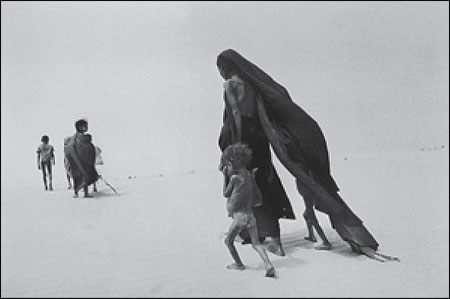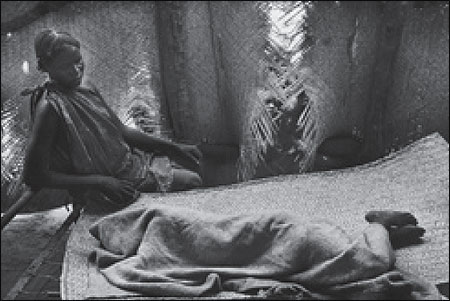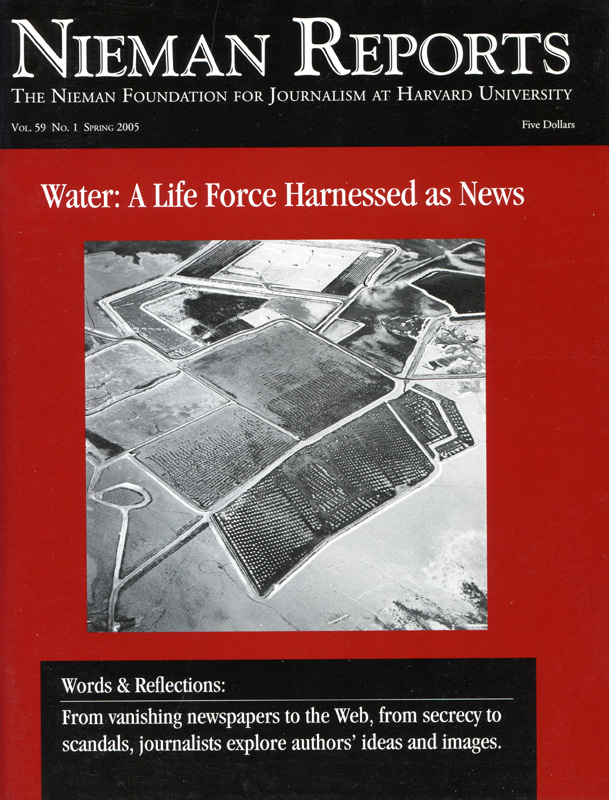“Sahel: The End of the Road” is a book of searing photographs taken 20 years ago by Brazilian-born photographer Sebastião Salgado during a famine that killed a million people in the droughtstricken countries of West Africa. (Sahel, which comes from the Arabic word for “edge” or “border,” is land at the edge of the desert, and Salgado’s photographs were taken in Chad, Ethiopia, Mali and the Sudan.)
His black and white photographs pair unforgettable horror with great beauty, and they represent everything that is meaningful, controversial and difficult about “concerned photography.” Salgado, a relatively unknown photographer in the mid-1980’s (his first career was as an economist), was unable to find an American book publisher for the work. One book agent was moved to tears by the photographs, but publishers said no one would buy such a book. Some of the photographs were published at the time in The New York Times and Newsweek, and they were published in book form in France in 1986 and in Spain in 1988.
Since then, Salgado has become arguably one of the world’s best-known photographers, and many of the Sahel photographs have become so well known they are icons to the photographers of my generation. Finally, in 2004, these images—accompanied by essays about them—were published in the United States as a book, the third in a series of books on contemporary photography by the University of California’s Graduate School of Journalism, in association with the University of California Press.
In the intervening years, Salgado’s work has evoked intense responses, not all of which are complimentary. In 1991, in her New Yorker article about the Sahel photographs, Ingrid Sischy wrote “Salgado is far too busy with the compositional aspects of his pictures—with finding the ‘grace’ and ‘beauty’ in the twisted forms of his anguished subjects. And this beautification of tragedy results in pictures that ultimately reinforce our passivity toward the experience they reveal. To aestheticize is the fastest way to anesthetize the feeling of those who are witnessing it. Beauty is a call to admiration, not to action ….” And in her recent book, “Regarding the Pain of Others,” the late Susan Sontag referred to Salgado (in an uncomplimentary way) as a photographer who “specializes in world misery.”
Sontag’s label is one I believe Salgado should wear with pride. It is a testimony to the importance of his work. “The First World is in a crisis of excess,” Salgado says, “the Third World in a crisis of need.”
As we look at these Sahel photographs, we can’t help but think of the people struggling today in the Darfur region of Sudan, not only from the effects of famine, but from ethnic cleansing as well. Though the locations of tragedies change, Salgado’s images remind us, if we need such reminding, that the visual telling of loss and grief, so personal, is also universal. His photographs provide a humane, epic look into the lives and deaths of people who inhabit places that few of us would pause to consider on our own.
The aesthetic and ethical response to such photographs can and will be debated for as long as these images exist. But what can’t be denied is the importance of photographers willing to bear witness, with visual strength, so all of us can see.
Michele McDonald, a 1988 Nieman Fellow, is a photographer with The Boston Globe, whose assignments have taken her to many developing nations.

In the region of Lake Faguibine, nomads have had to walk across the desert in 122-degree heat to reach the outskirts of cities in the hopes of fi nding food and shelter. In this area, one of the most prosperous villages of Azouera once stood, on the shores of a great lake that has now disappeared. Mali, 1985. Photo by Sebastião Salgado from the book “Sahel: The End of the Road,” University of California Press.

Korem camp was situated at a very high altitude (about 8,200 feet). At night the temperature often dropped to freezing. Nighttime was when the greatest number of deaths occurred. Ethiopia, 1984. Photo by Sebastião Salgado from the book “Sahel: The End of the Road,” University of California Press.

A mother looked helplessly at her child, who suffered from cerebral malaria. They arrived at the camp in the Darfur region of Sudan too late; the disease was irreversible. 1985. Photo by Sebastião Salgado from the book “Sahel: The End of the Road,” University of California Press.
Image quality was intetionally degraded for Web use by request.
His black and white photographs pair unforgettable horror with great beauty, and they represent everything that is meaningful, controversial and difficult about “concerned photography.” Salgado, a relatively unknown photographer in the mid-1980’s (his first career was as an economist), was unable to find an American book publisher for the work. One book agent was moved to tears by the photographs, but publishers said no one would buy such a book. Some of the photographs were published at the time in The New York Times and Newsweek, and they were published in book form in France in 1986 and in Spain in 1988.
Since then, Salgado has become arguably one of the world’s best-known photographers, and many of the Sahel photographs have become so well known they are icons to the photographers of my generation. Finally, in 2004, these images—accompanied by essays about them—were published in the United States as a book, the third in a series of books on contemporary photography by the University of California’s Graduate School of Journalism, in association with the University of California Press.
In the intervening years, Salgado’s work has evoked intense responses, not all of which are complimentary. In 1991, in her New Yorker article about the Sahel photographs, Ingrid Sischy wrote “Salgado is far too busy with the compositional aspects of his pictures—with finding the ‘grace’ and ‘beauty’ in the twisted forms of his anguished subjects. And this beautification of tragedy results in pictures that ultimately reinforce our passivity toward the experience they reveal. To aestheticize is the fastest way to anesthetize the feeling of those who are witnessing it. Beauty is a call to admiration, not to action ….” And in her recent book, “Regarding the Pain of Others,” the late Susan Sontag referred to Salgado (in an uncomplimentary way) as a photographer who “specializes in world misery.”
Sontag’s label is one I believe Salgado should wear with pride. It is a testimony to the importance of his work. “The First World is in a crisis of excess,” Salgado says, “the Third World in a crisis of need.”
As we look at these Sahel photographs, we can’t help but think of the people struggling today in the Darfur region of Sudan, not only from the effects of famine, but from ethnic cleansing as well. Though the locations of tragedies change, Salgado’s images remind us, if we need such reminding, that the visual telling of loss and grief, so personal, is also universal. His photographs provide a humane, epic look into the lives and deaths of people who inhabit places that few of us would pause to consider on our own.
The aesthetic and ethical response to such photographs can and will be debated for as long as these images exist. But what can’t be denied is the importance of photographers willing to bear witness, with visual strength, so all of us can see.
Michele McDonald, a 1988 Nieman Fellow, is a photographer with The Boston Globe, whose assignments have taken her to many developing nations.

In the region of Lake Faguibine, nomads have had to walk across the desert in 122-degree heat to reach the outskirts of cities in the hopes of fi nding food and shelter. In this area, one of the most prosperous villages of Azouera once stood, on the shores of a great lake that has now disappeared. Mali, 1985. Photo by Sebastião Salgado from the book “Sahel: The End of the Road,” University of California Press.

Korem camp was situated at a very high altitude (about 8,200 feet). At night the temperature often dropped to freezing. Nighttime was when the greatest number of deaths occurred. Ethiopia, 1984. Photo by Sebastião Salgado from the book “Sahel: The End of the Road,” University of California Press.

A mother looked helplessly at her child, who suffered from cerebral malaria. They arrived at the camp in the Darfur region of Sudan too late; the disease was irreversible. 1985. Photo by Sebastião Salgado from the book “Sahel: The End of the Road,” University of California Press.
Image quality was intetionally degraded for Web use by request.




